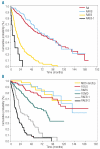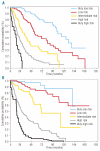Risk assessment in myelodysplastic syndromes and myelodysplastic/myeloproliferative neoplasms
- PMID: 21357714
- PMCID: PMC3046263
- DOI: 10.3324/haematol.2010.030023
Risk assessment in myelodysplastic syndromes and myelodysplastic/myeloproliferative neoplasms
Figures


Comment in
-
Evaluation of overall survival according to myelodysplastic syndrome-specific comorbidity index in a large series of myelodysplastic syndromes.Haematologica. 2011 Oct;96(10):e41-2. doi: 10.3324/haematol.2011.048991. Haematologica. 2011. PMID: 21972212 Free PMC article. No abstract available.
Similar articles
-
The myelodysplastic syndromes and myeloproliferative disorders.Clin Lab Sci. 2004 Fall;17(4):223-34. Clin Lab Sci. 2004. PMID: 15559729 Review.
-
Non-infectious pulmonary complications of myelodysplastic syndromes and chronic myeloproliferative disorders.Rev Mal Respir. 2011 Jun;28(6):e18-27. doi: 10.1016/j.rmr.2009.04.001. Epub 2011 Jun 8. Rev Mal Respir. 2011. PMID: 21742229 Review.
-
The landscape of myeloid neoplasms with isochromosome 17q discloses a specific mutation profile and is characterized by an accumulation of prognostically adverse molecular markers.Leukemia. 2016 Jul;30(7):1624-7. doi: 10.1038/leu.2016.21. Epub 2016 Feb 9. Leukemia. 2016. PMID: 26859077 No abstract available.
-
Evaluation of overall survival according to myelodysplastic syndrome-specific comorbidity index in a large series of myelodysplastic syndromes.Haematologica. 2011 Oct;96(10):e41-2. doi: 10.3324/haematol.2011.048991. Haematologica. 2011. PMID: 21972212 Free PMC article. No abstract available.
-
Is chronic myelomonocytic leukemia more akin to myelodysplastic or myeloproliferative neoplasms and does it matter?Leuk Lymphoma. 2008 Jul;49(7):1225-7. doi: 10.1080/10428190802187189. Leuk Lymphoma. 2008. PMID: 18604709 No abstract available.
Cited by
-
Influence of Prognostic Factors on OverallSurvival in Myelodysplastic Syndromes.Mater Sociomed. 2014 Oct;26(5):292-6. doi: 10.5455/msm.2014.26.292-296. Epub 2014 Oct 29. Mater Sociomed. 2014. PMID: 25568624 Free PMC article.
-
Impact of the degree of anemia on the outcome of patients with myelodysplastic syndrome and its integration into the WHO classification-based Prognostic Scoring System (WPSS).Haematologica. 2011 Oct;96(10):1433-40. doi: 10.3324/haematol.2011.044602. Epub 2011 Jun 9. Haematologica. 2011. PMID: 21659359 Free PMC article.
-
Refractory thrombocytopenia and neutropenia: a diagnostic challenge.Mediterr J Hematol Infect Dis. 2015 Feb 18;7(1):e2015018. doi: 10.4084/MJHID.2015.018. eCollection 2015. Mediterr J Hematol Infect Dis. 2015. PMID: 25745545 Free PMC article. Review.
-
Reproducibility of the World Health Organization 2008 criteria for myelodysplastic syndromes.Haematologica. 2013 Apr;98(4):568-75. doi: 10.3324/haematol.2012.071449. Epub 2012 Oct 12. Haematologica. 2013. PMID: 23065505 Free PMC article.
-
Prognostic factors in myelodysplastic syndromes.Maedica (Bucur). 2012 Dec;7(4):295-302. Maedica (Bucur). 2012. PMID: 23483702 Free PMC article.
References
-
- Cazzola M, Malcovati L. Myelodysplastic syndromes--coping with ineffective hematopoiesis. N Engl J Med. 2005;352(6):536–8. - PubMed
-
- Swerdlow SH, Campo E, Harris NL, Jaffe ES, Pileri SA, Stein H, et al. WHO classification of tumours of haematopoietic and lymphoid tissues. Lyon: IARC; 2008.
-
- Bennett JM, Catovsky D, Daniel MT, Flandrin G, Galton DA, Gralnick HR, et al. Proposals for the classification of the myelodysplastic syndromes. Br J Haematol. 1982;51(2):189–99. - PubMed
-
- Vardiman JW, Harris NL, Brunning RD. The World Health Organization (WHO) classification of the myeloid neoplasms. Blood. 2002;100(7):2292–302. - PubMed
Publication types
MeSH terms
Substances
LinkOut - more resources
Full Text Sources
Medical

